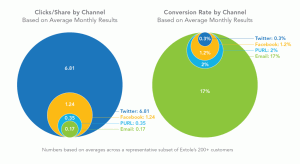Social Sharing: Twitter has highest amplification rate, email has highest conversion rate
While researching an upcoming consumer marketing case study about SquareTrade, a provider of extended consumer electronics warranties that tied a referral program to the release of the latest iPhone, I had the chance to speak with Angela Bandlow, Vice President Marketing, Extole, a consumer-to-consumer social marketing company that creates social referral programs. (Note: You can sign up for the Consumer Marketing newsletter to receive the case study on SquareTrade once it’s published.)
Social referral programs allow companies to tap into their customer advocates to promote their brands, products and services by getting those customers to share within their social networks. These programs then track the shares through to the conversion, whether that is a sale, an opt-in or a coupon redemption.
Extole recently conducted research on 20% of its customer base with an average data collection length of 45 weeks, and this research uncovered some interesting data points on social sharing among different companies.
What to measure when tracking social sharing
“If you think about a referral program, it’s a little different in terms of what you would measure than a standard marketing program,” Angela explains.
She offers a few areas to track with referral programs:
- How many of your customers are participating in your program? These people are called “advocates” at Extole.
- Of the people participating, how many people do they share with, and through what marketing channel — email, Facebook, Twitter, personal URL (PURL), etc. This metric is important because it shows the “amplification” of the message or call-to-action.
- The number of social shares is the multiplication of the number of participants and the amount of sharing.
- Clicks-per-share, or in other words, the rate of clicking with the social shares from your customers.
“You see a different rate of amplification across social channels versus email,” says Angela. “Email is always going to be a one-to-one share.”
Extole’s research found in aggregate its clients get 3.49 shares per advocate. In other words, everyone participating in a referral program is sharing with almost three and a half friends. On the high end, some advocates share with as many as 12 friends.
Here is a breakdown of some of the data points across several channels:
- The largest percentage of advocate sharing is through email, and those shares get a 21% open rate, 80% clickthrough and 17% conversion (the highest conversion rate of any channel), which breaks down to .17 clicks per share.
- Facebook shares average 1.24 clicks per share, but the conversion rate is only 1.21%.
- Twitter actually averages 6.81 clicks per share, which creates the highest amplification rate of any channel.
This research also found an overall average of 42% clickthrough rate through social referral programs and almost five friend clicks per share for highly performing programs.
Angela also offers a couple of examples from different clients:
A video rental service company gets the majority of its shares through people who get a personal URL and share it through various channels through cutting and pasting. This referral program includes an incentive offer of a free one-night rental for the customer advocate and a first night free rental for the friends.
Extole has found that amplification is improved when the effort involves an incentive.
A food delivery service gets 70% of its shares through email and another 15% via Facebook. On Twitter, that company gets almost nine clicks for each tweet.
“We’ve always known that word-of-mouth marketing was very powerful, and converted at an estimated three to five times higher rates than other channels,” states Angela. She adds this research puts some data behind the marketing power of letting your customers drive conversions through their social networks and communication channels.
Related Resources:
Email Summit: Integrating mobile, social and email marketing channels
Social Media Marketing: Social login or traditional website registration?
Social Media Marketing: A look at 2012, part 1
Social Media Marketing: A look at 2012, part 2
Social Media Marketing: Analytics are free and plentiful, so use them
Using Social Sharing to Achieve Specific Email Goals: 5 Insights
New Chart: Increasing Reach through Social Sharing
Categories: Social Networking Evangelism Community amplification rate, conversion, social media, social sharing











Great post! Do you have any figures on % of total users that become advocates? Thanks